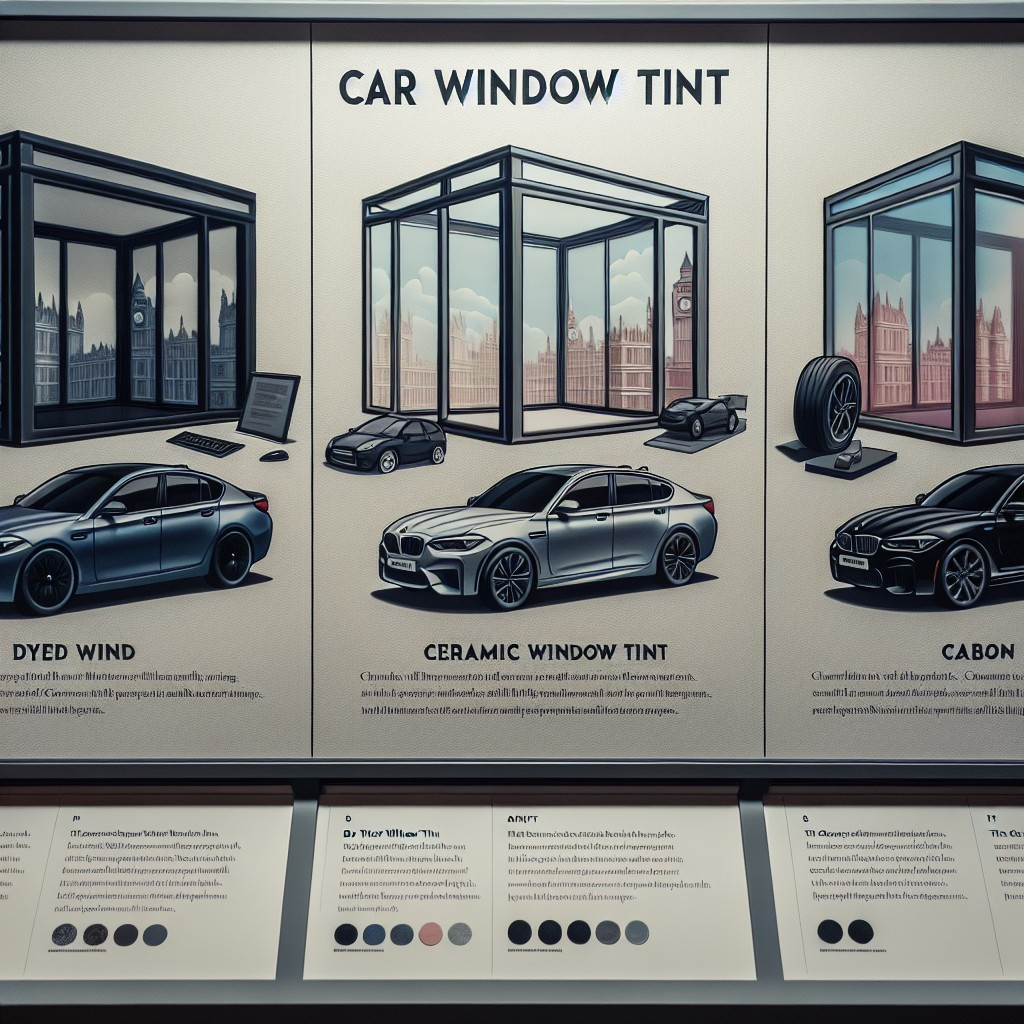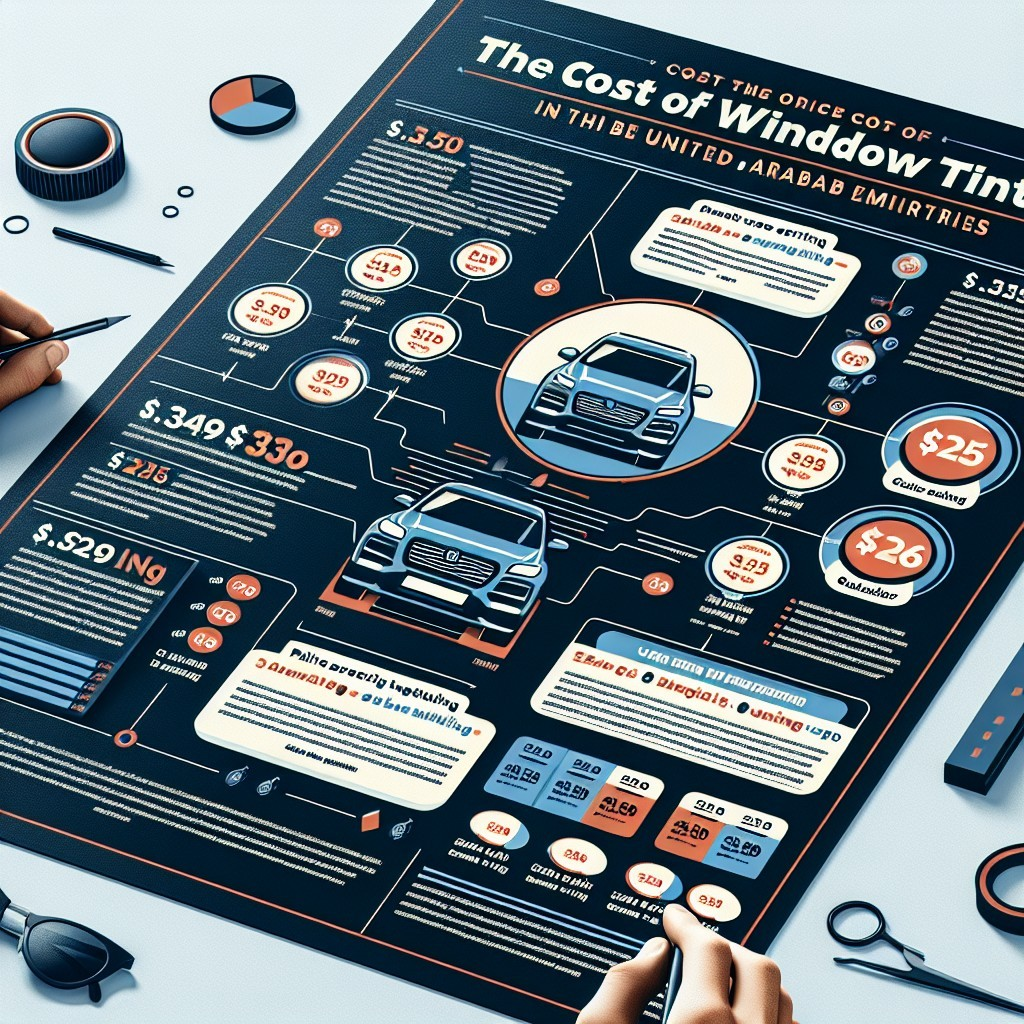When it comes to enhancing the aesthetics and functionality of your vehicle, window tinting is a popular choice. Not only does it offer privacy and style, but it also provides protection against harmful UV rays and heat. However, not all window tints are created equal; In this article, we will explore the various types of car window tint available on the market today, including dyed, ceramic, carbon, and others, helping you make an informed decision for your vehicle.

1. Dyed Window Tint
One of the most common types of window tint is dyed film. This option involves a layer of dye that is applied between the adhesive and protective layers of the film. Dyed window tint is known for its affordability and aesthetic appeal.
- Advantages:
- Cost-effective solution for budget-conscious consumers.
- Available in various shades to match your style.
- Reduces glare and improves privacy without compromising visibility.
- Disadvantages:
- Less effective at blocking heat compared to other types.
- Can fade over time due to sun exposure.
- Does not provide as much UV protection as other films.
2. Carbon Window Tint
Carbon window tint is a more advanced option that incorporates carbon particles into the film. This type of tint offers a sleek, matte finish and is known for its durability and performance.
- Advantages:
- Blocks up to 40% of infrared light, keeping your vehicle cooler.
- Does not fade over time, maintaining its appearance.
- Provides a higher level of UV protection than dyed films.
- Disadvantages:
- Moderately priced, which may be a consideration for some consumers.
- Installation can be more complicated than dyed films.
3. Ceramic Window Tint
Ceramic window tint is the crème de la crème of window films. Made with advanced nano-ceramic technology, this type of tint offers exceptional performance without compromising visibility.
- Advantages:
- Blocks up to 99% of harmful UV rays.
- Exceptional heat rejection properties, keeping your vehicle cool.
- Highly durable and resistant to fading or discoloration.
- Signal-friendly, allowing for uninterrupted GPS and mobile device signals.
- Disadvantages:
- Typically the most expensive option on the market.
- Installation requires a professional to ensure optimal results.
4. Metalized Window Tint
Metalized window tint incorporates tiny metallic particles that reflect sunlight. This type of film is known for its strength and effectiveness.
- Advantages:
- Offers excellent heat and UV blockage.
- Highly durable and resistant to scratches.
- Provides additional strength to the glass, helping to prevent shattering.
- Disadvantages:
- Can interfere with electronic signals, such as GPS and cell phone reception.
- Generally more expensive than dyed films.
5. Hybrid Window Tint
Hybrid window tint combines elements of dyed and metalized films. This type of tint aims to provide the best of both worlds, delivering aesthetics and performance.
- Advantages:
- Offers a good balance between cost and performance.
- Reduces glare and heat while providing a stylish look.
- Less prone to fading than dyed films.
- Disadvantages:
- May not provide as much heat rejection as high-end ceramic films.
- Durability can vary based on the quality of the film.
Choosing the right type of car window tint depends on your specific needs, budget, and personal preferences. Whether you’re looking for an affordable dyed tint, the durability of carbon, or the advanced technology of ceramic films, there’s a perfect option out there for you. Always consult with a professional installer to ensure that you select the best film for your vehicle and comply with local regulations regarding window tinting.
Investing in quality window tint not only enhances your car’s appearance but also provides protection and comfort on the road. Make an informed choice and enjoy the benefits of your new car window tint!
As we delve deeper into the world of car window tinting, it’s essential to understand not just the types available but also the unique benefits and potential applications of each. Let’s explore how these tints can cater to various needs, whether for aesthetics, comfort, or protection.
Choosing the Right Tint for Your Needs
When selecting a window tint, consider your specific requirements. Are you primarily interested in enhancing your vehicle’s appearance, or is your main goal to improve heat reduction and UV protection? Each type of tint serves a different purpose:
- Dyed Window Tint: Ideal for those seeking a simple aesthetic upgrade at an economical price. Its primary role is to provide a sleek look while offering minimal protection against heat and UV rays.
- Carbon Window Tint: Perfect for drivers wanting a balance of style and performance. It not only looks great with its matte finish but effectively blocks infrared light, making your ride more comfortable.
- Ceramic Window Tint: For the discerning car owner who prioritizes performance and durability. This premium option ensures maximum UV protection and heat rejection, making it ideal for those in sunny climates.
- Metalized Window Tint: This option is suitable for those looking for durability and strength. It’s great for enhancing the integrity of your windows while providing superior heat and UV protection.
- Hybrid Window Tint: If you’re looking for versatility, a hybrid tint combines the best features of dyed and metalized films, making it a great all-around choice.
Legal Considerations
Before making a decision, it’s crucial to familiarize yourself with local laws regarding window tinting. Regulations can vary significantly by state or country, affecting the degree of tint allowed on different windows. Ensure that the tint you choose complies with these regulations to avoid potential fines or the need for costly removals.
Installation: DIY or Professional?
While some may consider a DIY approach for window tinting, professional installation is often recommended, especially for higher-end films like ceramic or carbon tints. Professionals ensure that the film is applied correctly, minimizing the risk of bubbles, creases, or misalignment, which can diminish the film’s effectiveness and appearance. Additionally, a professional installer can better navigate any legal considerations regarding tinting.
Maintenance and Care
Once your window tint is installed, understanding how to maintain it is crucial for longevity:
- Cleaning: Use a gentle cleaner and a soft cloth to avoid scratching the film. Avoid ammonia-based products, as they can damage the tint.
- Avoiding Excessive Heat: In the early days after installation, avoid rolling down your windows to allow the adhesive to cure properly and prevent bubbling.
- Regular Inspections: Periodically check for any signs of peeling or damage, especially after extreme weather conditions.
Exploring the Benefits and Applications of Different Types of Car Window Tint
As we delve deeper into the world of car window tinting, it’s essential to understand not just the types available but also the unique benefits and potential applications of each. Let’s explore how these tints can cater to various needs, whether for aesthetics, comfort, or protection.
When selecting a window tint, consider your specific requirements. Are you primarily interested in enhancing your vehicle’s appearance, or is your main goal to improve heat reduction and UV protection? Each type of tint serves a different purpose:
- Dyed Window Tint: Ideal for those seeking a simple aesthetic upgrade at an economical price. Its primary role is to provide a sleek look while offering minimal protection against heat and UV rays.
- Carbon Window Tint: Perfect for drivers wanting a balance of style and performance. It not only looks great with its matte finish but effectively blocks infrared light, making your ride more comfortable.
- Ceramic Window Tint: For the discerning car owner who prioritizes performance and durability. This premium option ensures maximum UV protection and heat rejection, making it ideal for those in sunny climates.
- Metalized Window Tint: This option is suitable for those looking for durability and strength. It’s great for enhancing the integrity of your windows while providing superior heat and UV protection.
- Hybrid Window Tint: If you’re looking for versatility, a hybrid tint combines the best features of dyed and metalized films, making it a great all-around choice.
Before making a decision, it’s crucial to familiarize yourself with local laws regarding window tinting. Regulations can vary significantly by state or country, affecting the degree of tint allowed on different windows. Ensure that the tint you choose complies with these regulations to avoid potential fines or the need for costly removals.
While some may consider a DIY approach for window tinting, professional installation is often recommended, especially for higher-end films like ceramic or carbon tints. Professionals ensure that the film is applied correctly, minimizing the risk of bubbles, creases, or misalignment, which can diminish the film’s effectiveness and appearance. Additionally, a professional installer can better navigate any legal considerations regarding tinting.
Once your window tint is installed, understanding how to maintain it is crucial for longevity:
- Cleaning: Use a gentle cleaner and a soft cloth to avoid scratching the film. Avoid ammonia-based products, as they can damage the tint.
- Avoiding Excessive Heat: In the early days after installation, avoid rolling down your windows to allow the adhesive to cure properly and prevent bubbling.
- Regular Inspections: Periodically check for any signs of peeling or damage, especially after extreme weather conditions.
Final Thoughts
So whether you’re cruising down the highway or parked in the sun, the right window tint will keep you cool, comfortable, and stylish. Don’t underestimate the power of a good tint—it’s an investment that pays off in both aesthetics and functionality.


I found this article incredibly helpful! The detailed descriptions of dyed, carbon, and ceramic tints really helped me understand what would work best for my car. Great job!
A fantastic read! I had no idea there were so many options for window tinting. The pros and cons listed are very useful in making a decision. Thank you for sharing!
I loved this article! The insights on UV protection and heat blocking capabilities were particularly enlightening. I feel much more informed about my options now!
This article is a must-read for anyone considering window tinting. The clarity in explaining each type makes it easy to understand which would be the best fit for my needs.
This article provides an excellent overview of the different types of window tints available. I especially appreciated the breakdown of advantages and disadvantages for each type. Very informative!